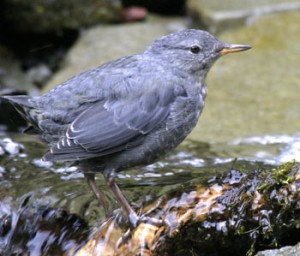Nature Notes by Dr. Frank Lang
When I was growing up in Western Washington my father took me fishing. A familiar sight, sometimes more familiar than that of fish, was a stocky slate-gray thrush-sized bird flying up and down the stream, occasionally lighting on an emergent rock or boulder. Once alight, the bird bobbed up and down in a most curious fashion. Papa called them teeter-asses, a name I found both descriptive and hilarious. Not till some time later did I learn that, in the polite society of bird watchers, they were called water ouzels or, to be correct today, the American dipper.
Bobbing up and down on rocks was not the only curious thing they did. They would suddenly fly beneath the water, then disappear to emerge downstream with aquatic insect larvae in their bills. They also include small fish and an occasional streamside insect in their diet. Underwater they can fly to depths below 20 feet with powerful wingbeats. This bird looks like a song bird (which it is) and swims, without the benefit of the usual accouterments of waterfowl: no webbed feet, lobed toes or duck-like bill.
That is not to say they don’t have adaptations, they do. They have a much larger oil gland than other songbirds, scales that close the nostrils while immersed, a thick, eyelid that flicks across the eye to keep it clean in murky water. They swim by flying through the swift water of their mountain streams or walking along the bottom, gripping with their oversized feet.
A songbird you say? You bet. The dipper’s call is a simple, loud “zeet, zeet,” single or repeated. it song is a clear and ringing rendition of trills and flute-like whistles like a mockingbird embellishing upon a wren’s song.
It sings year round, rain or shine, by day and occasionally at night. Its song will lift your spirits no matter what your mood or no matter what the weather.
Most of our mountain streams support populations of American dippers. A good place to look for them is Ashland Creek in the heart of Lithia Park. If you don’t see the birds themselves, look for their calling cards, white speckles on rocks emerging from the middle of the stream, their contribution to the nitrogen cycle.Where do teeters…ah, dippers nest? They nest on cliff faces among the mosses and ferns, on midstream rocks, or behind water falls. Nestlings are quite precocious and can climb, swim, and dive when they leave the nest.
— Dr. Frank Lang


